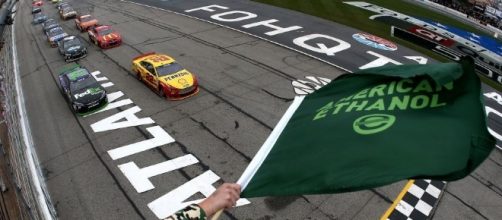The Atlanta Motor Speedway will be repaved after being used for almost 20 years without a facelift. It is considered the oldest racing surface in pro racing. The resurfacing of the one and a half mile long race track will begin after the Folds of Honor QuikTrip 500 race. The paving of the track should not take long to complete. Regular maintenance of race tracks is integral to the safety of participants and onlookers alike.
The Speedway surface get lots of love
The longevity of the Atlanta Motor Speedway surface is credited to the generally mild winters in Georgia and excellent maintenance.
However, after 20 years of use and thousands of laps from race cars, the pavement must ultimately be replaced. Track resurfacing can cause issues for drivers. A newer race track has more traction because the heat from the tires has not polished the surface of the asphalt just yet. The heat created by the friction of the tires running multiple laps over the same area wears down asphalt and makes a smoother surface. This smooth, also polished, surface enables a car to travel faster over a race track than when the surface is still rough from resurfacing. Once the new racing season begins again, drivers will face a totally new experience from what they are used to at Atlanta, and many become very unhappy with resurfaced race tracks.
Resurfacing at Atlanta Motor Speedway to avoid dangerous situation
Resurfacing a race track is a necessity. Race tracks can become worn or damaged by weather, groundwater, unstable substrate, repeated use, leaked mechanical oils and lubricants and fuel. When a race track becomes worn, pieces of pavement may come loose just like they do on a freeway.
But when you’re traveling 200 mph, a pothole or loose piece of pavement can be life threatening. This loosened pavement creates a danger to drivers, pit crews, and spectators. Loose pavement can sometimes be corrected before a race during test runs or a safety inspection, but a patch on the pavement is a temporary solution.
Large pieces of pavement have hit cars in the past. Jeff Gordon's car was hit by asphalt during a race in 2004. The chunk of flying pavement left the car undrivable and postponed the race. Similar instances of race track damage have occurred during the 2010 Daytona 500 and the FedEx 400 races. Resurfacing a track is the best way to prevent further damage and injury.
Racetrack history
The Atlanta Motor Speedway hosted its first race in July 1960. Built by several developers after the success of the Daytona Speedway, the Atlanta Motor Speedway became a stop on the Winston Cup Circuit. The track became very popular with professional drivers after its first renovation in 1997.
The first race held at Atlanta was held under rough conditions.
The project had not been fully completed and many amenities were still under construction. The speedway has had its share of struggles, even declaring bankruptcy at one point. The planned race track resurfacing is the latest in updates for the Atlanta Motor Speedway.

